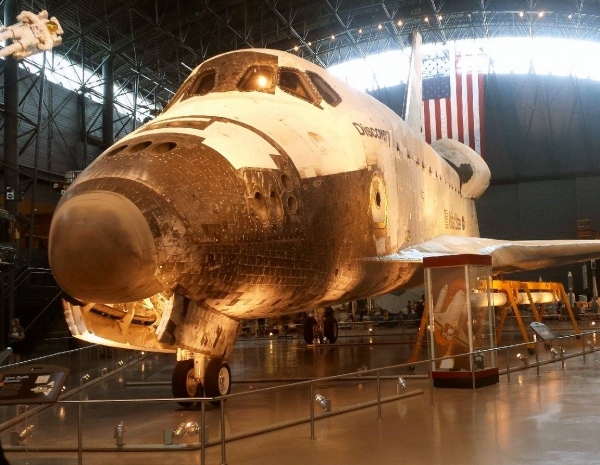LONDONDERRY — I recently returned home after a two-day, 1,000 mile trip to see the Space Shuttle Discovery, which is now on display in the Smithsonian National Air and Space Museum at Dulles Airport in Virginia.
Discovery logged 150 million miles and 365 days in orbit before being retired in 2011 when the shuttle program was cancelled. This remarkable machine is a triumph of U.S. engineering and raw science that helped our economy to flourish, beginning with early space exploration in the 1950s and extending to right now.
President Eisenhower first saw the promise of space for both military and economic strength, and he directed Congress to create the National Aeronautical Space Agency in 1958. The United States began its push into space behind the Soviet Union but quickly accelerated the program.
And in 1962, President Kennedy boldly established the Apollo mission, which culminated with Neil Armstrong stepping onto the surface of the moon seven years later.
* * *
The shuttle program followed Apollo, with grand plans for further manned missions throughout our solar system, first to explore space, but also to build technologies that would drive economic growth at home.
The successes were staggering, but over the past few decades, NASA's budgets have been cut, and the nation is no longer capable of launching and supporting such extraordinary manned space exploration.
Even the New Horizons program, which just flew by Pluto with great fanfare after nine years in space, is ancient history in NASA budgeting. The New Horizons mission first secured funding in 2001, but that funding was eliminated by the Bush administration in 2002 and only reluctantly restored in 2003 following a public backlash.
While NASA continues with some exploration and science work, federal budget cuts have prevented the agency from making grand commitments and maintaining the infrastructure needed to fully explore and understand our galaxy.
* * *
My trip to Virginia began in Vermont, and was only possible because of the foresight of President Eisenhower, who, in addition to founding NASA, also championed the Interstate highway system.
On my 1,000-mile trip, I passed by Albany, Scranton, Harrisburg, and Hagerstown before making my way east to Dulles International Airport, and then returning home by way of Washington, Baltimore, Philadelphia, Newark, and New York City.
I was delayed by heavy construction in many places, especially along the Interstate 95 corridor, but I was also delayed by crumbling highways that limited speed and thrashed my car's suspension along most of the journey.
President Eisenhower understood the importance of land infrastructure to link our cities so that commerce and military hardware could move easily from coast to coast.
When he launched the Interstate highway system, President Eisenhower built roads, and he also built the foundation of an economy that allowed our nation to prosper.
Today, the roads and bridges designed decades ago are crumbling into failure, and shipping has been slowed to a near standstill in many places. The federal trust fund that finances the national highway system is nearly insolvent.
Congress has failed to pass long-term funding, and only reluctantly agreed to a three-month extension of the Highway Trust Fund to pay for essential summertime construction that is already underway.
* * *
The effects of decades of underfunding and congressional inaction are obvious along the Interstate highway system, although less obvious and of greater concern is the lost productivity and increased transportation costs levied on every resident of the U.S.
President Eisenhower, a Republican war hero of World War II, understood that economic growth requires robust and well-funded infrastructure, and he championed multiple federal programs that would lead to national prosperity and security.
He oversaw a budget that was reasonably well-funded with low deficits and a low debt, but with high top marginal tax rates.
He recognized that government-funded investment would help private businesses to prosper, and those businesses in turn would employ American workers.
He understood the importance of a well-trained and financially secure American workforce that could be quickly shifted from civilian to military production whenever the world needed saving, and he understood the value of civilian sacrifice in time of war.
President Eisenhower presided over a strong economy with top marginal tax rates of 91 percent, which held steady at more than 70 percent until President Reagan slashed top tax rates in the false hope that lower rates would yield a larger tax base.
We now see the wealthiest Americans paying a maximum marginal rate of just 39 percent, when they pay anything at all.
With lower tax rates on the wealthiest Americans and the failure of Reagan's predictions, our deficits have grown and now limit even basic spending.
* * *
The Eisenhower programs that led to our prosperity, including NASA and the Interstate highway system, are collapsing while the Republican Congress looks to cut taxes even further and underfunds the infrastructure that has formed the foundation of our prosperity.
If this country is to grow again, we must reinvest in our infrastructure, including roads and scientific discovery, and we must raise taxes to cover those investments.
President Eisenhower showed us the way, and the growth that followed demonstrated he was a Republican who got it right.
It's time to go back to those core values of public investment, with high top-tier tax rates, so we can move forward to a renewed prosperity.
